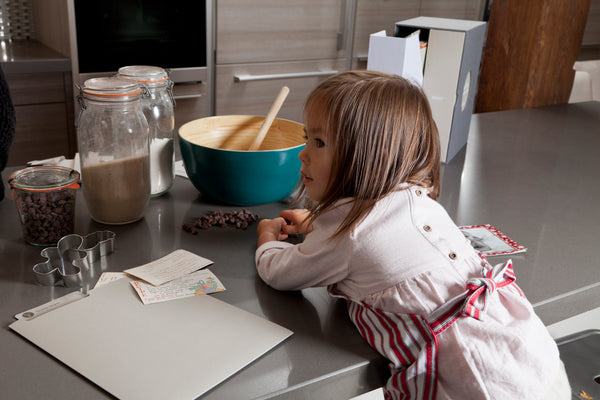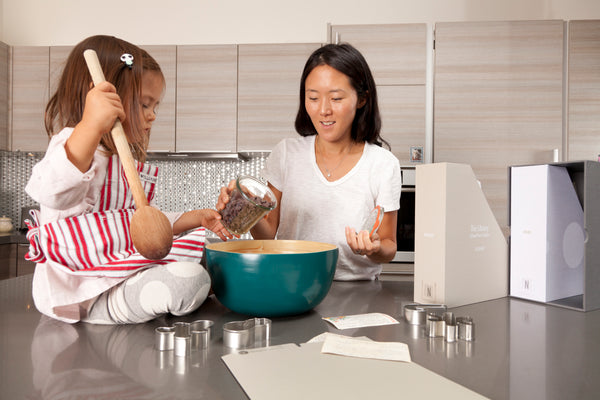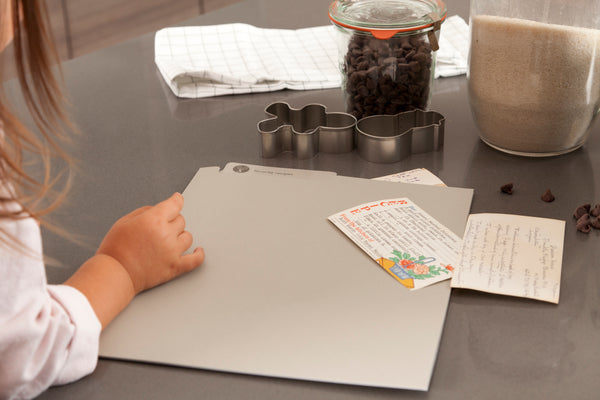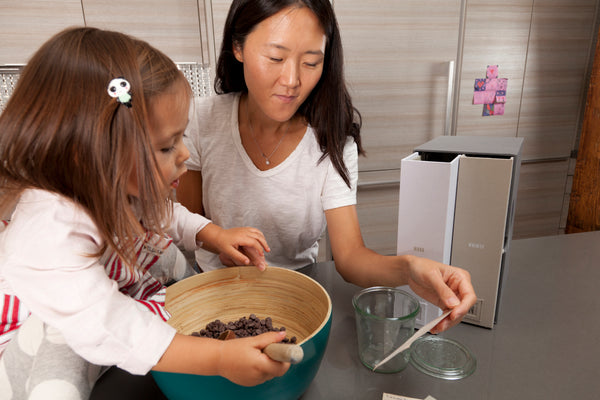Holiday Cooking with Kids without Losing Your Mind--Do's & Don'ts


Some of our best family memories, probably 80% of them, involve food. But it’s not just the eating of it. Cooking together with our kids, especially around the holidays, has become a family tradition. There’s no denying that cooking with young children takes longer, can be more frustrating, and is certainly messier than doing it yourself. We’re not even going to wade into the morass that emerges when two kids want to cook and somehow the other person always gets the best job and it’s always the other one who didn’t clean up.
But cooking as a family also yields amazing benefits, from better eaters to smoother meal times. It’s a great way to build motor skills, math, science, and risk taking. And, of course, there’s the ultimate goal—kids who can take over the nightly meal prep. (A mom can dream, can’t she?). So despite the caveats, we stick with it. As Thanksgiving approaches, we’ll be dusting off my grandmother’s family recipe box (Yes, there’s a Savor keepsake box sticker for that!), don our mom and mini aprons, and get cooking. Here are some of our top tips, groomed over years of our own childhood cooking experiences, as well as from cooking with kids as young as 2.

- DON’T worry about the mess
A friend once told me “even the worst messes take only about 20 minutes to clean up.” We start with this, because it’s this fear that keeps so many of us from bringing our kids into the kitchen in the first place. I repeat this to myself when the flour is everywhere.
- DO make them help with the clean-up
Cooking isn’t just about the mixing and the sampling. Even the youngest child can dry a dish or put something in the dishwasher.

- DO give them a leg-up
For the youngest of kids, these counter stool towers are an amazing way to level the kitchen playing field, literally. No more standing on a rickety chair to be level with you, these stools bring them right into the stirring action.
- DO invest in a kids’ cookbook
There are tons of great kid-friendly recipes online, of course. But if you want them to be able to go back and forth referring to the ingredients, nothing builds the self-reliance better than a kids’ cookbook. Many don’t require reading. Plus, the pictures alone get them excited. We like Moosewood's Mollie Katzen's kids cookbook Pretend Soup and other Real Recipes.

- DON’T shy away from adult foods
This may seem to contradict #4, but while we believe in doing kid-focused dishes, it’s amazing how excited kids are to eat food that they’ve been involved in making. This is a great way to introduce them to new foods.
- DO keep it all in the family
If you already have family traditions, pass these along. Cooking is a great grandparent activity. But if you don’t have family recipes, find a recipe you love making together and make it—often. There is no better cooking lesson than cooking the same thing many times.
- DO let them play with knives.
Well, not exactly play. But we subscribe to the philosophy set forth by the founder of Tinkerschool and frequent TedTALK lecturer, Gever Tulley, who explains with a few simple rules – always cut away from you, hold the knife by covering the blade – kids can use knives in way that is both powerful and empowering.

- DON’T crack the eggs right into the bowl.
It almost doesn’t matter what age your child is, unless they’re ready for Top Chef there will be shell in the bowl. Adding eggs one at a time minimizes the damage.
- DO let them lick the bowl(ish).
Good cooks taste their food. Frequently. So, we encourage this. But that’s different from using fingers that get licked and put back into the bowl. We do two things to combat this. First, we keep out a cup of spoons—every time you taste, you use a new spoon. Second, if we do see fingers go in, we don’t make a big deal, but we do require automatic hand washing. Usually, the inconvenience itself cuts down on the paws in the batter.

- DO talk about the science and math as you go
Baking teaches fractions far more easily than a math teacher. Butter alone taught my children the concept of parts and wholes, equivalencies of halves and quarters, and the relationship between weights and dry measurements. Doubling recipes, too, gives a great visual for multiplication.
- DO have a mess bowl
This is a great tip for all cooks, not just kids, that I learned from Rachael Ray. Keep out a big garbage bowl into which all scraps go as you cook. (We even use ours for You can sort it later. It saves endless trips back and forth to the sink and the garbage can, especially since you’ll have more of both of these with the kids involved.

- DO read the recipe
This sounds obvious, but at least my young children often think they know better than the recipe and decide to ignore it and then cry when the cupcakes don’t rise. Or my teenager will start cooking only to realize halfway through that she’s missing an important ingredient. Also, it’s worth reminding them that baking, especially, is science, and exactness (until you’re more comfortable in the kitchen) can be the difference between success and failure.

- DO plan ahead
Needless to say, this isn’t the thing to do the night before Thanksgiving when you’re already behind. We do a lot of recipes for the holidays in the weekends beforehand and then freeze them. We love this cranberry sauce, for example, which can be made weeks before the family celebration and is a great kid-friendly recipe.
- DO remember it’s about having family time together than the end result
I mostly think this is true. Or at least, when the kitchen is a mess and the cookies are burned, that’s what I try to remind myself.

